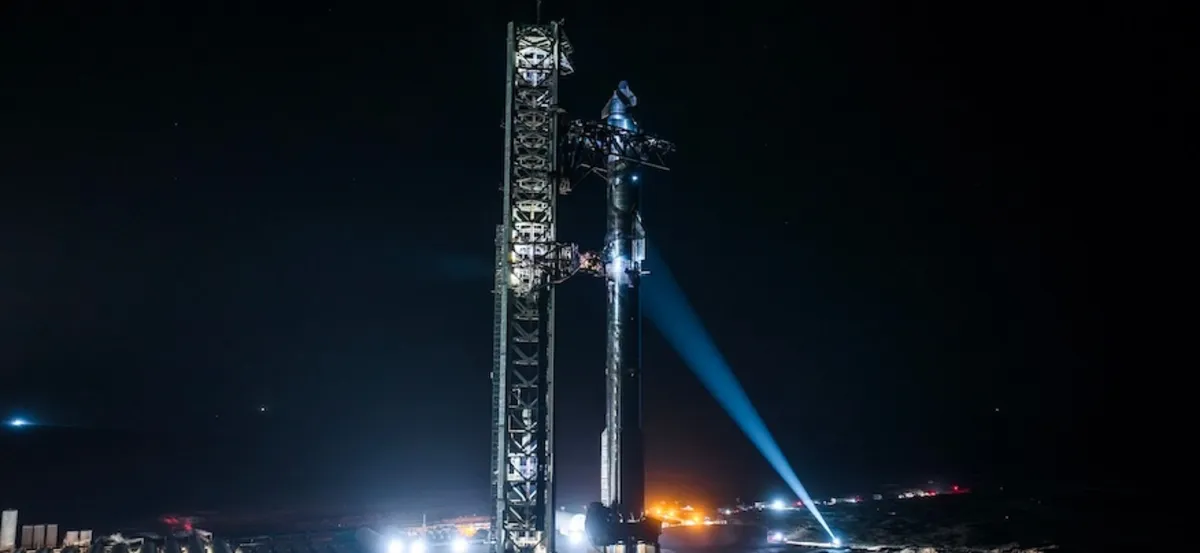
SpaceX is gearing up for the launch of its latest Starship test flight from its Starbase facility located in southern Texas, with liftoff scheduled for Monday, March 3, at 5:30 p.m. CST (6:30 p.m. EST, 2330 UTC). The Federal Aviation Administration (FAA) granted approval for this mission on February 26, allowing the company to proceed with its plans.
This upcoming mission aims to fulfill the objectives set for January’s flight test of the towering rocket, known as Flight 7, which ended prematurely with the destruction of the upper stage over the Turks and Caicos Islands. The current mission will launch the Super Heavy booster with tail number B15, alongside the Ship upper stage (also referred to simply as Starship), designated S34. This marks the second attempt by SpaceX to launch a Block 2 Starship.
Spaceflight Now will provide joint live coverage with LabPadre, starting approximately two hours before the scheduled liftoff. The mission will involve a series of demonstrations, including the relight of a Raptor engine in space, the deployment of simulator Starlink Version 3 satellites, and a propulsive splashdown in the Indian Ocean shortly after launch.
If conditions are favorable, Booster 15 will aim to return to the launch site and be caught by the chopstick arms on the tower, affectionately named ‘Mechazilla.’ If successful, this would mark the third successful catch out of four attempts. It’s worth noting that SpaceX chose to waive a catch attempt during the previous mission, Flight 6, due to a tower-related issue.
In its continuous effort to improve the Starship rocket, SpaceX has refined the fueling and mission timelines. During this launch, the loading of liquid oxygen on both the upper stage and booster will occur a few seconds earlier than previous missions, while the loading of liquid methane will happen slightly later. The overall launch timeline remains similar to that of Flight 7, with key payload deployment and Raptor engine relight demonstrations occurring nine and five seconds earlier, respectively.
SpaceX explained that these adjustments aim to address the objectives left unfulfilled during January’s flight. The upcoming flight plans to follow the same suborbital trajectory as previous missions, targeting objectives that include Starship’s first payload deployment and multiple reentry experiments aimed at returning the upper stage for a successful catch.
One notable change for this flight is the reduction in the number of Starlink simulators being deployed. Flight 7 aimed to deploy 10 dummy satellites, but Flight 8 will only include four. SpaceX has not provided a specific reason for this reduction. If successful, the deployed payload will follow the same suborbital trajectory as S34 and is designed to burn up in the atmosphere, with any debris expected to fall into the Indian Ocean.
In a detailed blog post, SpaceX outlined the challenges faced during the January Flight 7 mission. The primary issue was the inability to exceed approximately five minutes of flight without losing communication with S33, leading to its destruction less than 12 minutes into the mission. The company noted that it last received telemetry from the vehicle around eight minutes and 20 seconds into the flight.
SpaceX reported that the loss of communication occurred before any parameters were violated that would have triggered the Autonomous Flight Safety System (AFSS). The company identified the root cause of the failure as a harmonic response that was significantly stronger during the flight than during prior testing, resulting in increased stress on the propulsion system and subsequent propellant leaks.
While the FAA has cleared SpaceX to proceed with the launch of Flight 8 after a comprehensive safety review, it emphasized that the investigation into the Flight 7 mishap remains ongoing. SpaceX is working to conclude this investigation or secure a flight safety determination prior to the upcoming launch. This evaluation includes an assessment of the anomaly’s circumstances, safety-critical systems, and environmental factors.
In response to the challenges faced during Flight 7, SpaceX has implemented several changes, including the addition of a new nitrogen purge system and extra vents to minimize the risk of fires in the attic area of the Starship. Looking ahead, future versions of Starship will feature the Raptor 3 engine, which is expected to help reduce attic volume and eliminate most joints that could potentially leak.
SpaceX conducted an extended-duration static fire test with the Starship in preparation for Flight 8, aimed at addressing the harmonic response observed during the previous mission. Findings from this static fire led to hardware changes, adjustments to propellant temperatures, and new thrust targets for the upcoming flight test.
The Super Heavy booster from Flight 7 performed well overall, with a notable exception during the boostback burn, where one of the planned engines failed to reignite. SpaceX plans to implement a pre-planned igniter upgrade for the Raptor engines on upcoming flights to prevent such issues.
Among the design modifications for the Starship Block 2 are catch fittings, which will be tested for their thermal performance during Flight 8. While these fittings are not weight-bearing, they signify SpaceX's ongoing commitment to enhancing the reusability of its spacecraft.
Elon Musk, the founder of SpaceX, hinted at the possibility of future upper stage catch attempts in a recent statement, emphasizing the need for additional data before proceeding. He expressed optimism about achieving full reusability of the Starship and its booster in the upcoming years.
As SpaceX continues to innovate and refine its technology, the upcoming Flight 8 mission holds significant promise for the future of space travel and the company's ambitious goals.